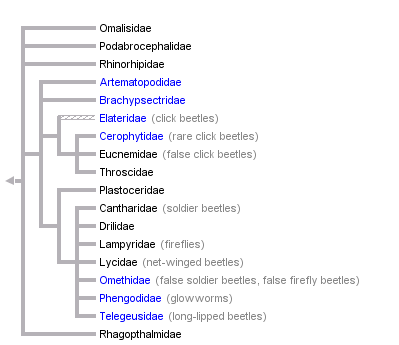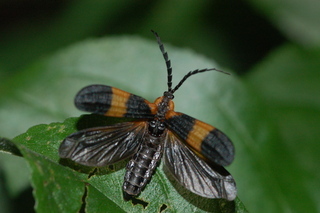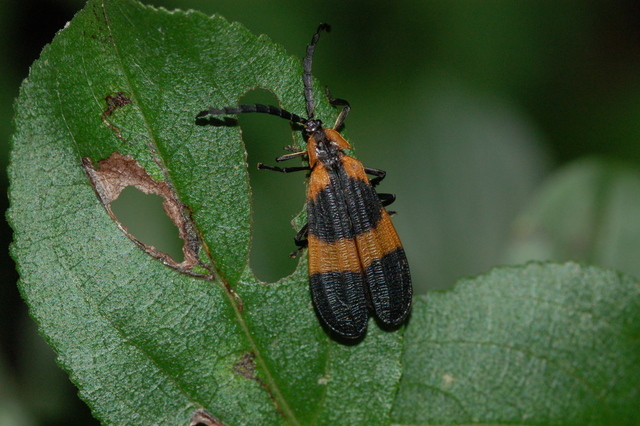Take a journey into the taxonomic past of Calopteron reticulatum!
Domain: Eukarya
Kingdom: Animalia
Phylum: Arthropoda
Class: Insecta
Order: Coleoptera
Family: Lycidae
Genus:
Calopteron
Species:
Calopteron reticulatum

If you want to discover more about the Banded Net-Winged
Beetles phylogeny, click on the arrow on the far left once you
arrive on the Tree of Life Web Project site.
Domain:
Eukarya The Banded Net-Winged Beetle is a member of the Domain
Eukarya. A common synapomorphy for Eukaryotic organisms is that they
have a distinct nucleus which contains the organisms genetic
material, also known as DNA. Working through to the major clades,
another synapomorphy that arises is the presence of membrane bound
organelles and later, multicellular and unicellular organisms
(Campbell et al. 2008).
Kingdom: Animalia (Animals) C. reticulatum is a member of the
Kingdom Animalia. One characteristic of organisms that belong to
Kingdom Animalia is that they belong to the Major clade Opisthokonta
which are characterized by posterior flagella that propel them
forward. Additionally, another feature that characterizes organisms
in Kingdom Animalia is that they are heterotrophic, meaning that
they cannot make their own food (Campbell et al. 2008).
Phylum: Arthropoda (Arthropods) One of the characteristics
that makes this beetle an arthropod is its exoskeleton which as
noted on the homepage, is composed of chitin. Unlike humans,
arthropods do not have Calcium, which is a main component in our
skeletal support systems (Arnett 2000). Additionally, arthropods
cannot make their own food like plants can with photosynthesis and
therefore are heterotrophs.
Class: Insecta (Insects) One common characteristic of insects
is that their body consists of three parts, the head, thorax and
abdomen. Some also have the ability to fly while others cannot fly.
Additionally, like many other organisms, insects are heterotrophic.
Some of them drink the blood of other animals while some eat the
flesh of plants (Marshall 2006).
Order: Coleoptera (Beetles and Weevils) The Order Coleoptera
is characterized by having modified front wings that protect a
beetle's or weevil's membranous wings. This is also the largest
order of insects. Additionally, another characteristic about
Coleoptera is that each organism starts in an egg and grow to an
adult (Meyer 2009).
Family: Lycidae (Net winged Beetles) Many species in
family lycidae will aggregate at some point in their life. The point
of the Banded Net-Winged Beetle’s life cycle where it aggregates is
in the larvae stage prior to pupation (Hall et al. 2008). Family
lycidae species also contain chemicals that make them toxic to
predators. This characteristic is present in C. reticulatum in its
ability to deter predators with its foul taste which is explained
more in Form and Function.
Genus: Calopteron (terminale Orange Wing) Our beetle fits
perfectly under the genus Calopteron because the amazing pattern on
its wings. The Greek translation for “calo” is beautiful, and
“pteron” (a version of ptera) is wing; therefore, beautiful wing is
a perfect match for this beetle. Worldwide, there are approximately
150 species with three species of these unique fliers located in the
Midwest region of the United States.
Species: Calopteron reticulatum (Banded Net-wing)
Calopteron
reticulatum is the specific scientific name the beetle for which
this site is dedicated to. "Calopteron" is the genus name of this beetle
as seen above and "reticulatum" is the specific epithet.
This beetle in part gets its name from its reticulated or banded
pattern on its wings. Keep reading
on, the journey hasn’t quite ended yet.
Phylogenetic trees
Phylogeneetic trees are use in biology to map
species evolution accross linages and times. These trees consist of
branches that split into different directions at points called
nodes. Nodes are splits in a phylogenetic tree that give evidence
that there was a synapomorphic divergence or converenge to a
species. Additionally, each label in the below phylogenetic tree
represents a new synampomorphy which could be an internal or
external physical characteristic.
Figure 1. Calopteron reticulatum is a Eukaryotic organism that has evolved within the Phylum Arthropoda. Photo used with permission by Rya Haag 2014.
Calopteron reticulatum as noted above as being a member of the
Phylum Arthropoda. Phylum Arthropoda is also within the Kingdom
Animalia. As you may observe below, Phylum Arthropoda is the sister
taxa of Phylum Nematoda. Two organisms that are identified as
nematodas are your common earthworm that some people use as bait for
fishing and leeches, which are commonly known as blood suckers.
Additionally, Calopteron
reticulatum shares the synapomorphy labeled "molting." Molting
is a term that refers to the shedding of an external exoskeleton
during the life cycle of an organism. External exoskeletons until
bone in the Chordates does not grow with the organism and therefore
the organism must get rid of the exoskeleton. Also, one of the main
differences between an exoskeleton and bone tissue is that bones
contain Calcium and the exoskeletons contain Chitin, which is a
non-living support material.
A few other synapomorthic characteristics that Calopteron
reticulatum has is that it is triploblastic and a protostome.
Organisms that are triploblastic also have bilateral symmetry which
means that if one were to slice them in two, both sides would look
identical. Additionally, organisms that are known to be protostomes
had their mouth form first and then their anus.
Come learn more about the Banded Net-Winged Beetle's Habitat and Geography

